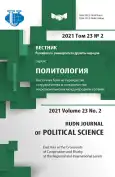The Key Components of South Korea’s Soft Power: Challenges and Trends
- Autores: Matosian A.E.1
-
Afiliações:
- Peoples’ Friendship University of Russia (RUDN University)
- Edição: Volume 23, Nº 2 (2021): East Asia at the Crossroads of Cooperation and Rivalry at the Regional and International Levels
- Páginas: 279-286
- Seção: SOFT POWER AND PUBLIC DIPLOMACY IN EAST ASIA
- URL: https://journal-vniispk.ru/2313-1438/article/view/322123
- DOI: https://doi.org/10.22363/2313-1438-2021-23-2-279-286
- ID: 322123
Citar
Texto integral
Resumo
To this day political processes are less and less impacted by military force. States are increasingly resorting to the use of means of latent influence or relying on cultural attraction. Such phenomena have led to the emergence of soft power in international relations. Many countries, including the Republic of Korea, effectively use soft power tools in implementing policies at various levels. This manuscript seeks to analyze the main soft power components and tools of the Republic of Korea in foreign policy. The paper examines the background of the formation and development of soft power strategies. Many factors have predetermined the growing popularity of Korean culture, a phenomenon subsequently called the Korean Wave (Hallyu). This paper identifies the main elements of the Hallyu, including public diplomacy and South Korea’s cultural economy exporting pop culture, entertainment, music, TV dramas, and movies, and examines how these elements complement each other.
Palavras-chave
Sobre autores
Agapi Matosian
Peoples’ Friendship University of Russia (RUDN University)
Autor responsável pela correspondência
Email: 1032192458@rudn.ru
ORCID ID: 0000-0002-7390-4268
Master Student of Political Science, Department of Comparative Politics
Moscow, Russian FederationBibliografia
- Cho, Y. (2012). Public diplomacy and South Korea’s strategies. The Korean Journal of International Studies, 10(2), 283-285.
- Choi, K.-J. (2019). The Republic of Korea’s public diplomacy strategy: History and current status. In CPD Perspectives (pp. 6-13). Los Angeles: Figueroa Press.
- Huang, X. (2009). Korean wave, the popular culture, comes as both cultural and economic imperialism in the East Asia. Asian Social Science, 5(8), 125-127.
- Jang, G., & Paik, W.K. (2012) Korean wave as tool for Korea’s new cultural diplomacy. Applied Sociology, 2(3), 196-202.
- Kang, H. (2015). Contemporary cultural diplomacy in South Korea: Explicit and implicit approaches. International Journal of Cultural Policy, 21(4), 433-447.
- Kim, H.J. (2018). Multi-Stakeholders in public and cultural diplomacies as seen through the lens of public-private partnerships: A comparative case study of Germany and South Korea. Journal of Contemporary Eastern Asia, 17(1), 68-93. doi: 10.17477/JCEA.2018.17.1.068
- Kim, W. (2015). Rising China, pivotal Middle Power South Korea, and alliance transition theory. International Area Studies Review, 18(3), 251-265. doi: 10.1177/2233865915595531
- Kwon, K. (2004). Regionalism in South Korea: Its origins and role in her democratization. Politics Society 32(4), 545-574.
- Lee, G. (2009). A theory of soft power and Korea’s soft power strategy. Korean Journal of Defense Analysis, 21(2), 205-218. doi: 10.1080/10163270902913962
- Lee, S.J. (2016). South Korea aiming to be an innovative Middle Power. In S.J. Lee (Ed.), Transforming Global Governance with Middle Power Diplomacy (pp. 1-15). New York: Palgrave Macmillan
- Nye, J. (1990). Bound to lead: The changing nature of American power. New York: Basic Books.
- Shin, S.O. (2016). South Korea’s elusive Middlepowermanship: Regional or global player? Pacific Review, 29(2), 187-209.
- Sohn, Y. (2011). Attracting neighbors: Soft power competition in East Asia. The Korean Journal of Policy Studies, 26(1), 90-95.
- Pershina, M.P. (2017). “Soft power” in the foreign policy of the Republic of Korea and the PRC. Ethnic society and interethnic culture, 2(104), 109-118.
Arquivos suplementares









